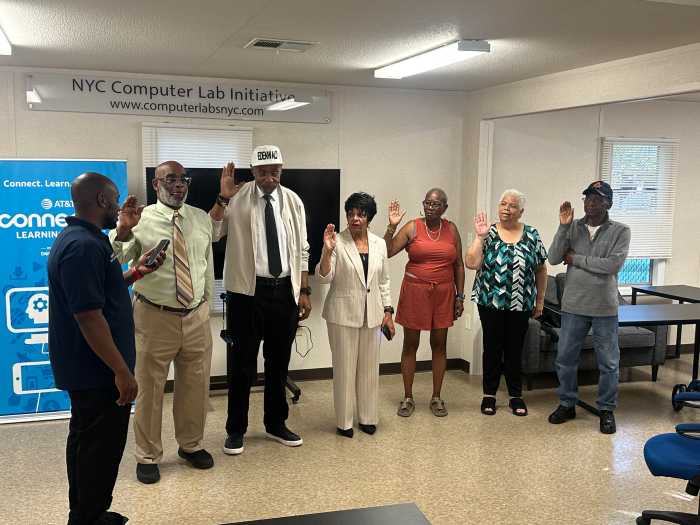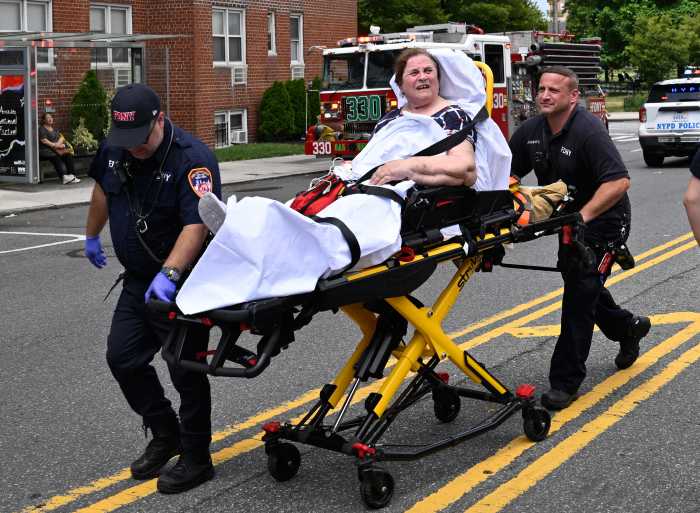BY DONNA MINKOWITZ | How do you live in New York City on $12 an hour or less, a typical Whole Foods wage? How can you buy organic food on even a middle class income here? How can you afford meat that doesn’t come from E. coli- laden feedlots where the animals have no room to lie down or move? How can you eat food that’s good for you and the planet without taking on (even more) debt?
These are the burning questions for anyone thinking about the politics of food in New York right now. (Here’s one more: how will the popularity of organics help the 1.4 million New Yorkers who currently depend on soup kitchens and food banks?) All of these questions come into play in the politics of Whole Foods, a “green mission” corporation so contradictory I had to write about it twice.
Last time, if you’ll remember, we were considering Whole Foods’ flagship store in Brooklyn, made of tastefully reclaimed bricks and wood but sitting on the banks of the Gowanus Canal, which seethes with PCBs, mercury, and pathogens. Activists had opposed the store’s siting because of the risks posed by dangerously polluted runoff from the channel, which floods regularly. They also said that the megastore would gentrify the neighborhood (leading to luxury condos that will make the canal even more flood-prone), and substitute low-paying Whole Foods jobs for the high-paying manufacturing jobs the neighborhood was previously zoned for.
Organic-enough and expensive, can its food sustain the earth and the workers who deliver it?
The last two predictions have already happened. (On the first point, environmental science suggests that the wetlands restoration locals were calling for would have provided much better protection for Brooklyn residents.) Still, Whole Foods is there now, and I myself, sadly, have bought barbecued organic turkey legs there. I’ve even enjoyed the beautiful roof deck/ restaurant/ bar, a half-indoor, half-outdoor space where sufficiently well groomed people can sit for hours and take in the view even if they haven’t purchased anything. The question for part two of this column is: Is Whole Foods— not just this store, but the entire corporation and its 412 stores around the country — good for the world or bad, beyond my personal convenience and enjoyment?
First, let’s talk about its major claim to fame — making organic food more available. Food activist and fermentation revivalist Sandor Katz, who is probably the most prominent LGBT voice in the food movement, said, “Whole Foods has gotten big through a strategy of swallowing up all the small local and regional natural food stores. Sourcing supposedly ‘organic’ produce and meat at the scale they’re doing it results in food that has much lower nutritional value and that is produced and distributed at a great cost to the environment.”
For example, said the former ACT UP/ New York member, “If you’re trying to raise pastured animals, there’s a limit to what scale you can do it at. If you have 5,000 cows, you can’t actually give them access to pasture.”
So your “grass-fed” burgers and “free-range” eggs may not be exactly that, depending on where you buy them. No matter what nice labels products are given, said Katz, “environmentally sound practices are far easier to do on a small scale.” Notably, most of Whole Foods’ product sourcing results in meat and produce being trucked for many hundreds or thousands of miles, leading to a far higher carbon output than farmers’ markets or food co-ops.
Katz’s first concern is echoed by nutrition scientist Marion Nestle, one of the doyennes of food activism in America, who said of the big agribusinesses that have become major players in organic farming, “Big Organic always tries to add more pesticides to what is allowed under the ‘Certified Organic’ label.” Fruit and vegetables can, in fact, be certified organic but still contain some pesticides, Nestle reports, and Big Organic is always pushing to allow more and more harmful chemicals to be allowed under the designation. Still, she said, “There was no place to get that kind of food in my neighborhood until Whole Foods came to New York. They have high quality food for people who can afford it.”
That category most definitely does not apply to Whole Foods’ workers. Ryan Faulkner, who worked at the store in San Francisco for two years and was an activist in the IWW’s union drive there in 2014, said that neither he nor his fellow employees could ever afford to shop there, despite their 20 percent employee discount.
“As a cashier, I was making $12 an hour — the checks were like jokes,” he said.
Even after Faulkner went on to receiving work in the regional distribution center, his wages only went up to $15.23. It wasn’t possible for employees to live on those wages inside the city limits, and many commuted two hours or more from outside the city. The other major grievance was computer-driven scheduling, which changed all workers’ schedules wildly week to week, “which made it impossible if you were going to school, or if you had kids,” Faulkner said. “The people with kids would just get in impossible situations. They would never know if they could pick their kids up.”
In fact, Rhiannon Broschat, a Chicago employee, was fired for staying home with her child when schools were closed because of the polar vortex last year, and Trish Kahle, another Chicago worker, was fired when she was injured in a bicycle accident but couldn’t bring in a doctor’s note to account for her absences because she couldn’t afford a visit to the doctor.
Worse, workers were pressured to work so much overtime and for so many days on end that, Faulkner said, accidents in the warehouse were common.
“The least you ever worked was 12 hour days, and it was frequently 16,” he said. “I saw one guy cut off a couple of his toes in the machinery. There was so much blood on the floor, but they just gave him a little award for working every day straight for a month.”
As in many companies today, Whole Foods has preferred to have fewer employees working many more hours than to have to hire more staffers, which would result in higher costs overall.
“They would threaten your job if you didn’t work 16 hours, and they put a lot of pressure on you to come in on your days off,” Faulkner said. “I once passed out in the freezer from exhaustion.”
If the chickens the store sold were treated in this way, Whole Foods co-CEO John Mackey would likely protest.
Whole Foods did not respond to repeated requests for comment.
If you’re wondering why Trish Kahle couldn’t see a doctor, take a good look at Whole Foods’ employee health insurance, where the individual deductible, Faulkner said, was $4,500 after the Affordable Care Act went into effect. (Employees at other locations have cited deductibles ranging from $3,500 to $5,000.) As a result, according to Faulkner and other workers, very few employees opt to use the coverage. (Whole Foods does offer health savings accounts to workers.)
In June, the New York City Department of Consumer Affairs announced that Whole Foods had been routinely overcharging its customers at all locations in the city.
“New Yorkers who shop at Whole Foods have a good chance of being overcharged,” the Department of Consumer Affairs’ Abigail Lootens told Gay City News. In DCA’s investigation, 80 different types of prepackaged goods (from baked goods to nuts to meat, cheese, and seafood) were found to have packages with wildly overstated weights. The lowest was an $.80 overcharge for a package of pecan panko, and the highest was an overcharge of $14.84 for a pack of coconut shrimp.
Journalist Tracie McMillan, who has covered the economics of Whole Foods extensively for Slate and the Food and Environment Reporting Network, said the systematic overcharging may be a result of “Whole Foods as a company having a culture of, ‘They’ll pay it! It’s fine!’” But as economist Richard Wolff has suggested, many of us are taking on further debt — for things exactly like overpriced coconut shrimp — in order to keep up with a lifestyle we imagine “normal” people can pay for.
“The bottom line is, Whole Foods is a big business,” said longtime New York State environmental activist Laura Haight. “They don’t care about us.”



























